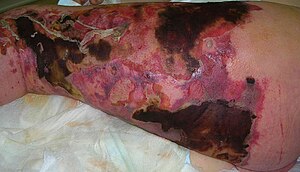Necrotizing fasciitis
This article relies largely or entirely on a single source. |
Necrotizing fasciitis also known as the "flesh-eating disease", is a rare and life-threatening infection that can happen if a wound gets infected. It needs to be treated in hospital away.[1]
| Necrotizing fasciitis | |
|---|---|
| Other names | Flesh-eating bacteria, flesh-eating bacteria syndrome,[2] necrotizing soft tissue infection (NSTI),[3] fasciitis necroticans |
 | |
| Person with necrotizing fasciitis. The left leg shows extensive redness and tissue death. | |
| Pronunciation | |
| Medical specialty | Infectious disease |
| Symptoms | Severe pain, fever, purple colored skin in the affected area[4] |
| Usual onset | Sudden, spreads rapidly[4] |
| Causes | Multiple types of bacteria,[5] occasional fungus[6] |
| Risk factors | Poor immune function such as from diabetes or cancer, obesity, alcoholism, intravenous drug use, peripheral artery disease[3][4] |
| Diagnostic method | Based on symptoms, medical imaging[5] |
| Differential diagnosis | Cellulitis, pyomyositis, gas gangrene[7] |
| Prevention | Wound care, handwashing[4] |
| Treatment | Surgery to remove the infected tissue, intravenous antibiotics[3][4] |
| Prognosis | ~30% mortality[3] |
| Frequency | 0.7 per 100,000 per year[5] |
The problem is treated very quickly under antibiotics. In more severe cases the area affected may need major surgery or amputation. Many people with the condition may also have other issues, such as diabetes. The condition is caused by bacteria.
Symptoms[change | change source]
Signs and symptoms of necrotising fasciitis can develop quickly within hours or over a few days.
At first there may be:[1][change | change source]
- intense pain or loss of feeling near to a cut or wound. The pain may seem much worse than what would usually be expected from a cut or wound
- swelling of the skin around the affected area
- flu-like symptoms, such as a high temperature, headache and tiredness
Later symptoms can include:[1][change | change source]
- being sick (vomiting) and diarrhoea
- confusion
- black, purple or grey blotches and blisters on the skin. These may be less obvious on black or brown skin
Necrotising fasciitis is very rare. The symptoms are similar to more common skin infections like cellulitis.
Causes[change | change source]
Necrotising fasciitis is an infection that can happen after getting a wound. It causes damage to the deep layers of the skin. The infection may get into the body through:[1]
People with diabetes or a weakened immune system may be more at risk of developing necrotising fasciitis.
Treatments[change | change source]
It must be treated in hospital as soon as possible. Treatment will usually include:[1]
- antibiotics
- surgery to remove tissue in the affected area
Even after successful treatment, there may be long-term changes in the bodies appearance and how it can move or be used at the affected part of the body. Sometimes amputation of affected limbs is needed.
There may be a need for further surgery and physiotherapy to help with recovery.
Related pages[change | change source]
 Media related to Necrotizing fasciitis at Wikimedia Commons
Media related to Necrotizing fasciitis at Wikimedia Commons- cellulitis
- gangrene
- necrosis
References[change | change source]
- ↑ 1.0 1.1 1.2 1.3 1.4 "Necrotising fasciitis". nhs.uk. 2017-10-19. Retrieved 2024-05-29.
- ↑ Rakel, David; Rakel, Robert E. (2015). Textbook of Family Medicine. Elsevier Health Sciences. p. 193. ISBN 9780323313087. Archived from the original on 2017-09-08.
- ↑ 3.0 3.1 3.2 3.3 Cite error: The named reference
Hak2014was used but no text was provided for refs named (see the help page). - ↑ 4.0 4.1 4.2 4.3 4.4 Cite error: The named reference
CDC2016was used but no text was provided for refs named (see the help page). - ↑ 5.0 5.1 5.2 Cite error: The named reference
Paz2014was used but no text was provided for refs named (see the help page). - ↑ Ralston, Stuart H.; Penman, Ian D.; Strachan, Mark W. J.; Hobson, Richard (2018). Davidson's Principles and Practice of Medicine E-Book. Elsevier Health Sciences. p. 227. ISBN 9780702070266.
- ↑ Ferri, Fred F. (2013). Ferri's Clinical Advisor 2014 E-Book: 5 Books in 1 . Elsevier Health Sciences. p. 767. ISBN 978-0323084314.
